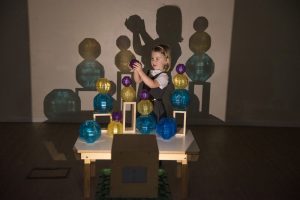As educators we are on a constant search to find innovative and exciting ways to engage, delight and motivate children. I would therefore like to share with you a little about a quest which is around the subject of light and how working with a hugely talented, patient and diligent team we attained our goal. 
Now I know that light has been used in learning environments for many years as a tool and as catalysts to encourage a sense of curiosity, provoke enquiry, investigation, creativity, scientific understanding, etc. and all within an atmosphere of awe and wonder. It already forms an integral part for many of you who are influenced and inspired by Malaguzzi’s advocation of the need to give children freedom, time, space and most importantly opportunities to use multiple materials and voices in their learning.
Light can be a truly transforming medium that can offer quite unique experiences, turning the ordinary object into the extraordinary. My quest for a very particular light source however came with clear caveats.
- I wanted to offer a truly STEAM based learning approach for the children, where subjects are blended, integrated and that give meaning and context.
- Technology needed to be integral, not to dominate but facilitate, enhance and enrich.
- The goal was for the children to control the technology, rather than just reacting to it.
- Children would be working with a rich plethora of materials and properties, ensuring they could play safely with and within the light itself.
- It was also to be robust, portable and look as if it was part of a construction or loose parts play area, but the big difference being that this block had the possibility to create a shadowy space whenever they chose.
- It was to be versatile, open-ended and accessible. It didn’t require specific resources so that you could utilise what you had. If you have an area where you can turn off the lights and a relatively small space, then you could begin.
- The last big ask, of course, was that it would be fun!

So, as you can see, quite a comprehensive list of key objectives. I should also say that the ability to create magical, mesmerizing, moments, full of wonder was non-negotiable.
The first major hurdle was how could I find a light source that met my criteria and importantly the safety directives around light and young children. These are quite rightly rigorous. I also wanted a rechargeable unit, with no trailing wires into the mains. I imagined the possibility of children being able to move around freely, imaginatively and even dance around in the light. It was also key that the children were the ones who positioned the light source, placed it where they chose and operated the switches independently. Ownership, being in control, leading, instigating were all the words whirling around my head.
Well after two years and working with partners around the world, a deceptively humble looking wooden box arrived. We had been waiting with great anticipation and it did not disappoint. The excitement went to a whole new level when we put this into the hands of the children. Seeing them so engaged, so enthralled, so curious was a delight.
Now it may appear very simplistic but looks can be deceiving. Once in use the powerful possibilities flooded forth.
The children were the curators, the engineers and designers. Materials took on whole new personas in the shadowy landscapes. The walls and ceiling became their artist’s canvas, adorned with patterns, shapes and a myriad of colours and hues. It is such a rich source of language from narratives to mathematical and scientific literacy. Words such as transparent, opaque, iridescent were uttered but all were fully grounded in context.

Magical carpet rides, underwater scenes with colourful fish, magical castles, mighty machines can all be conjured up. An ordinary object when placed in the light can be transformed, taking on special qualities. The construction play items and loose parts were utilised to create amazing scenarios.
The children were experimenting, exploring, predicting, modifying, testing, creating, persisting and so much more. They were the architects of the play, selecting their resources and using the light to enrich, transform and adorn their work. They were engineering, manipulating, joining and manoeuvring the materials and learning about their properties.
Every day we learn more about the possibilities that light offers and the children teach us what is possible. Light is such a fundamental part of our lives but utilising it in this way offers so much potential. Awe and wonder, enchantment, magical, mesmerising moments are at the centre of the play and that was our biggest objective.
Thank you to Catherine Clark, the Early Years New Product Development Director and in-house educationalist at TTS, for the content in this blog.



